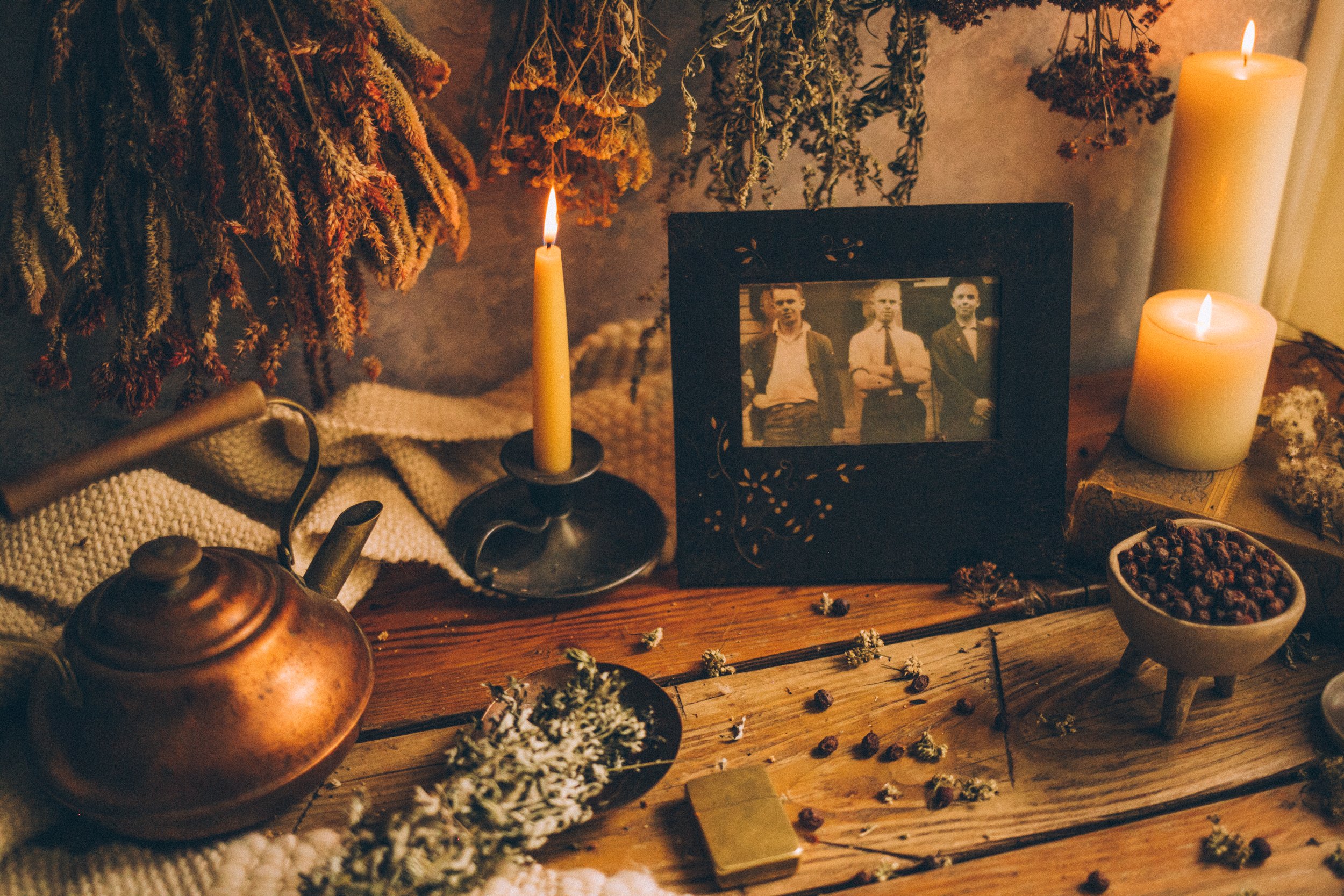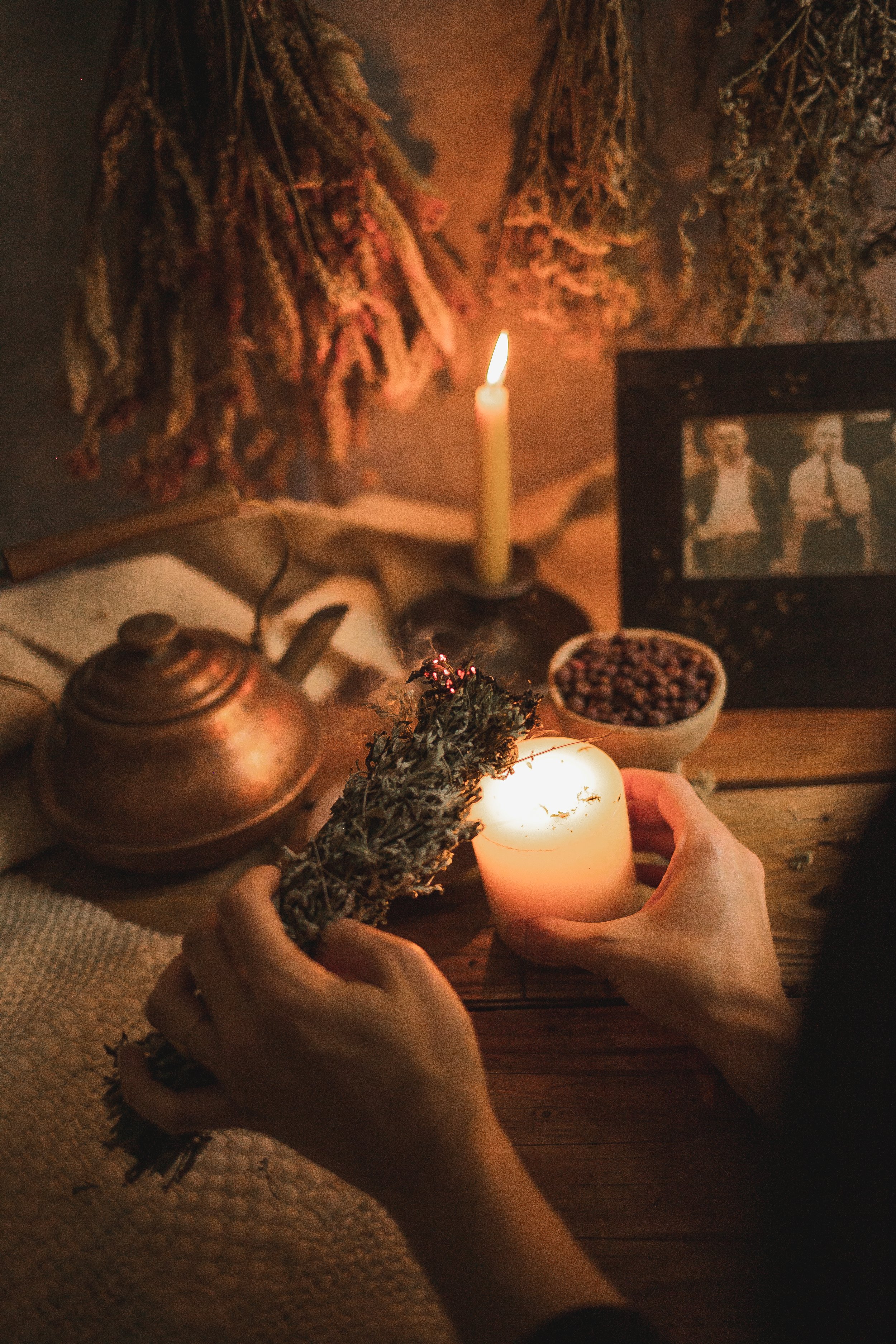Samhain Rituals, Hawthorn, and the Thinning of the Veil
When the leaves change colors and the wind brings a spine-tingling chill, you’ll know that Samhain is near. Samhain (pronounced “sah-win”) takes place on October 31-November 1 and is the ancient Celtic festival that the Christian church forcefully “rebranded” as All Saints Day in the eighth century. All Saints Day takes place on November 1, and the day before is All Hallows Eve, which later morphed into Halloween.
Just because the holiday received a new name, didn’t mean the original Samhain rituals and traditions went away. Many of the activities that we associate with Halloween today, including dressing up in costumes, trick-or-treating, and having a bonfire all have their roots in the original Celtic holiday mixed with Roman and Christian influence.
What is Samhain?
In the Celtic calendar, Samhain marks the end of summer and the harvest season, and the beginning of the dark, cold winter months. It falls opposite Beltane on May 1 (rebranded by the church as “May Day”), which represents the beginning of spring and the life-filled growing season.
It’s believed that the veil between the living and the dead is thinnest on Samhain. Historically, people were worried that they would encounter ornery spirits if they ventured outside on Samhain night, so they dressed as ghosts or wore masks to disguise themselves. Folks would leave treats on their front porch or place an extra setting at the table to welcome any friendly spirits who stopped by. You can see how these Samhain rituals easily morphed into our modern-day version of trick-or-treating in costume.
Nighttime bonfires were another of the long-standing Samhain rituals - this one was thought to help combat the impending darkness of winter and the fearful chill that accompanied the idea of roaming spirits. Because the veil between living and dead is believed to be the thinnest on this night, Samhain is also a powerful night for divination and spellcasting by candlelight.
Samhain and the Hawthorn Tree
Here at Hawthorn & Honey, we have a special connection with Hawthorn trees. Hawthorns have a long and rich history in folklore, and they’ve historically been seen as the gateway between the human and spirit world, making them a natural fit for Samhain.
It’s believed that faeries live in hawthorn trees, and the branches should only be harvested on Beltane so as not to disturb them and bring misfortune to your family. It’s also said that you have the best chances of seeing fairies if you spend time near a lone hawthorn tree on Beltane, Midsummer, or Samhain. (But be warned - Thomas the Rhymer, a 13th-century Scottish poet, sat under a hawthorn tree and then reported that a fairy queen took him to the underworld for 7 years!).
Do you know of a secluded hawthorn tree? If you dare, spend some time under its gnarled, berry-covered branches this Samhain and see whether any fairies come to visit.
The hawthorn tree also has darker associations with death, corpses, and magic. Christ’s crown was made of hawthorn branches, and people in medieval times associated the smell of hawthorn flowers with that of rotting corpses. Witches brooms are said to be made from hawthorn wood, and hawthorn wands were believed to be especially powerful.
Hawthorn trees can often be found planted near ancient cemeteries, stone circles, and relics - guarding the locals from spirits of the past. Hawthorns planted near sacred wells were believed to have powerful healing properties, and people would tie rags to the branches with the belief that the healing properties would be absorbed by the rag. We now know that hawthorn does, indeed, share a rich apothecary with us through its flowers, leaves, and berries, many of which are featured in our product line here at Hawthorn & Honey.
Samhain Rituals & Herbs
If, like me, you resonate with the spooky, spiritual vibes of Samhain - but you’re not really interested in dressing up in costume or going trick-or-treating, then you may enjoy some of these earth-centered, herbal Samhain rituals.
If you don’t have Celtic lineage or feel drawn to its history, then I’d also encourage you to explore related traditions from your ancestry. For example, the Day of the Dead is a beautiful and long-standing Mexican holiday that honors loved ones who have passed before us, and Daimonji is an annual Buddhist tradition where it’s believed that departed souls return every August to visit family.
Hawthorn (Crataegus spp.)
Hawthorn has historically been seen as the gateway between the human and spirit world, plus it’s rumored to be the most likely place to see fairies. To honor this tree on Samhain, sit at its base and give thanks for its protection. The berries are typically ready to harvest around Samhain, so bring a small basket and harvest enough to make a tincture or jam. You can also dry the berries and sprinkle them into your winter tea blends where they offer heart-supportive benefits, among other things. (Keep reading to see our Apple and Hawthorn Berry Tea recipe!)
I have a long-standing Samhain ritual of gathering hawthorn berries for my heart-soothing Hawthorn and Motherwort Elixir. I gather the hawthorn flowers on Beltane, wild roses in June, motherwort in July and August, rosehips in September, and finally the bright red hawthorn berries on Samhain. I love this tradition, and I can always feel the energy of the season as I label the jar and prepare it to slowly steep during the long, cold winter months ahead.
Mugwort (Artemisia vulgaris)
Mugwort is often used to enhance dreams and to aid in divination. It’s a popular ingredient in bedtime tea blends, and it’s thought to help repel negative energies and unwanted spirits - perfect for this spooky night!
Because the veil between the living and the dead is thinnest on Samhain, your dreams may result in supernatural encounters - are you up for it? To honor mugwort on Samhain, burn an aromatic mugwort wand and take a warm bath in mugwort-infused water. You could also infuse dried mugwort in olive oil for a dream-enhancing massage oil. Sip on some relaxing tea and set your dreamtime intentions before drifting to sleep. Be prepared for an interesting - and perhaps magical - night.
Rowan (Sorbus sp.)
Rowan trees have a long and sacred history. It’s said that if you plant a rowan bush near a grave, then it will keep the dead from rising. That may be a useful trick when it comes to Samhain, the night the spirits roam the streets.
In Scotland and parts of Northern England, rowan branches and berries are hung around the house to keep evil spirits away. If you don’t have access to a rowan tree, then you could purchase dried rowan berries, string them into a garland, and hang them across doorways and windows. This beautiful, autumnal decoration will last for months, so there’s no rush to take it down when Samhain ends.
Apples (Malus spp.)
Though not an herb, apples were seen as sacred to many ancient cultures and have long been incorporated into Samain rituals and feasts. Folks would leave apples on tables and porches as a food offering for spirits wandering past. Because apples were typically in season during Samhain, they were also featured in a variety of traditional Samhain meals, especially desserts.
Ancient Celts also used to tie apples to evergreen branches as a way to encourage the sun deity to return the following year and to offer thanks for the autumnal harvest.
Apple and Hawthorn Berry Tea
This warming, simple tea recipe honors the role that apples and hawthorn trees have both played in Samhain traditions for centuries. Apples were seen as a sacred sign of fertility and were featured heavily in Samhain meals and decor. Hawthorn trees have historically been known as the gateway between the worlds of the living and the dead, and on Samain, those worlds are closer than ever. This recipe makes 2 mugs - one for you, and one to leave on your table for any wandering spirits who may stop by.
Ingredients
1 apple, sliced
2 Tablespoon dried hawthorn berries (or 4 Tablespoons fresh)
1 cinnamon stick
A pinch of cloves
4 cups water
Honey, to taste (optional)
Instructions
Combine all ingredients in a small stockpot.
Bring to a boil, then reduce heat and simmer, covered, for 10 minutes.
Strain the plant material from the tea, then transfer the tea into two mugs.
Enjoy one for yourself, and leave the other on your table or front porch to nourish any wandering spirits who may pass while the veil between the living and the dead is thinnest.
Make a Samhain Altar
Samhain is also a wonderful time to make a sacred altar in your home. You can dedicate this altar to the harvest season, loved ones who have passed before you, or anything else that you’re called to focus on.
To make an altar, first find a corner of your home or a table surface where you can arrange a few treasures. You don’t need a ton of space. You could use the top of a dresser, the corner of your desk, an unused side table, etc.
Next, adorn that space with items that remind you of Samhain and the harvest season. A few items that you may want to include could be:
Beautiful autumn leaves or flowers that you collect on a nature walk
A candle
A mugwort bundle
A string of rowan beads
A bowl of apples or a small pumpkin
A hawthorn wand or bowl of freshly picked hawthorn berries
After you’ve assembled your altar, spend some time sitting quietly in the space. Light the candle and/or mugwort wand, sip on a cup of Apple & Hawthorn Berry Tea (recipe above) and meditate on this energetically powerful day.
If you enjoy reading tarot cards or journaling, then this would be an especially potent day to tune into your intuition.
Samhain is a sacred and beautiful time to slow down, listen to the wind, sit under a hawthorn tree, and open your mind to any magic that may filter through the thinning veil. I hope you all enjoy this enchanting holiday!
Are you interested in using this magical time to connect more deeply with the plants around you? If so, check out my Free Plant Communication Ebook for helpful insight and tips.






